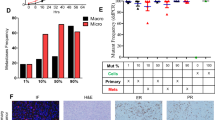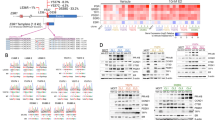Abstract
Seventy percent of breast cancers express estrogen receptor (ER), and most of these are sensitive to ER inhibition. However, many such tumors for unknown reasons become refractory to inhibition of estrogen action in the metastatic setting. We conducted a comprehensive genetic analysis of two independent cohorts of metastatic ER-positive breast tumors and identified mutations in ESR1 affecting the ligand-binding domain (LBD) in 14 of 80 cases. These included highly recurrent mutations encoding p.Tyr537Ser, p.Tyr537Asn and p.Asp538Gly alterations. Molecular dynamics simulations suggest that the structures of the Tyr537Ser and Asp538Gly mutants involve hydrogen bonding of the mutant amino acids with Asp351, thus favoring the agonist conformation of the receptor. Consistent with this model, mutant receptors drive ER-dependent transcription and proliferation in the absence of hormone and reduce the efficacy of ER antagonists. These data implicate LBD-mutant forms of ER in mediating clinical resistance to hormonal therapy and suggest that more potent ER antagonists may be of substantial therapeutic benefit.
This is a preview of subscription content, access via your institution
Access options
Subscribe to this journal
Receive 12 print issues and online access
$209.00 per year
only $17.42 per issue
Buy this article
- Purchase on Springer Link
- Instant access to full article PDF
Prices may be subject to local taxes which are calculated during checkout




Similar content being viewed by others
References
Early Breast Cancer Trialists' Collaborative Group (EBCTCG). Effects of chemotherapy and hormonal therapy for early breast cancer on recurrence and 15-year survival: an overview of the randomised trials. Lancet 365, 1687–1717 (2005).
Ariazi, E.A., Ariazi, J.L., Cordera, F. & Jordan, V.C. Estrogen receptors as therapeutic targets in breast cancer. Curr. Top. Med. Chem. 6, 181–202 (2006).
Strasser-Weippl, K. & Goss, P.E. Advances in adjuvant hormonal therapy for postmenopausal women. J. Clin. Oncol. 23, 1751–1759 (2005).
Forbes, J.F. et al. Effect of anastrozole and tamoxifen as adjuvant treatment for early-stage breast cancer: 100-month analysis of the ATAC trial. Lancet Oncol. 9, 45–53 (2008).
Peng, J., Sengupta, S. & Jordan, V.C. Potential of selective estrogen receptor modulators as treatments and preventives of breast cancer. Anticancer. Agents Med. Chem. 9, 481–499 (2009).
Wagle, N. et al. High-throughput detection of actionable genomic alterations in clinical tumor samples by targeted, massively parallel sequencing. Cancer Discov. 2, 82–93 (2012).
Cancer Genome Atlas Network. Comprehensive molecular portraits of human breast tumours. Nature 490, 61–70 (2012).
Gutierrez, M.C. et al. Molecular changes in tamoxifen-resistant breast cancer: relationship between estrogen receptor, HER-2, and p38 mitogen-activated protein kinase. J. Clin. Oncol. 23, 2469–2476 (2005).
Lipton, A. et al. Serum HER-2/neu conversion to positive at the time of disease progression in patients with breast carcinoma on hormone therapy. Cancer 104, 257–263 (2005).
Meng, S. et al. HER-2 gene amplification can be acquired as breast cancer progresses. Proc. Natl. Acad. Sci. USA 101, 9393–9398 (2004).
Jirström, K. et al. Adverse effect of adjuvant tamoxifen in premenopausal breast cancer with cyclin D1 gene amplification. Cancer Res. 65, 8009–8016 (2005).
Turner, N. et al. FGFR1 amplification drives endocrine therapy resistance and is a therapeutic target in breast cancer. Cancer Res. 70, 2085–2094 (2010).
Baselga, J. et al. Everolimus in postmenopausal hormone-receptor-positive advanced breast cancer. N. Engl. J. Med. 366, 520–529 (2012).
Nettles, K.W. et al. NFκB selectivity of estrogen receptor ligands revealed by comparative crystallographic analyses. Nat. Chem. Biol. 4, 241–247 (2008).
Zhang, Q.X., Borg, A., Wolf, D.M., Oesterreich, S. & Fuqua, S.A. An estrogen receptor mutant with strong hormone-independent activity from a metastatic breast cancer. Cancer Res. 57, 1244–1249 (1997).
Kato, S. et al. Activation of the estrogen receptor through phosphorylation by mitogen-activated protein kinase. Science 270, 1491–1494 (1995).
Le Goff, P., Montano, M.M., Schodin, D.J. & Katzenellenbogen, B.S. Phosphorylation of the human estrogen receptor. Identification of hormone-regulated sites and examination of their influence on transcriptional activity. J. Biol. Chem. 269, 4458–4466 (1994).
Anzick, S.L. et al. AIB1, a steroid receptor coactivator amplified in breast and ovarian cancer. Science 277, 965–968 (1997).
Azorsa, D.O., Cunliffe, H.E. & Meltzer, P.S. Association of steroid receptor coactivator AIB1 with estrogen receptor-α in breast cancer cells. Breast Cancer Res. Treat. 70, 89–101 (2001).
Fan, M., Park, A. & Nephew, K.P. CHIP (carboxyl terminus of Hsc70–interacting protein) promotes basal and geldanamycin-induced degradation of estrogen receptor-α. Mol. Endocrinol. 19, 2901–2914 (2005).
Chandarlapaty, S. et al. SNX2112, a synthetic heat shock protein 90 inhibitor, has potent antitumor activity against HER kinase–dependent cancers. Clin. Cancer Res. 14, 240–248 (2008).
Shang, Y. & Brown, M. Molecular determinants for the tissue specificity of SERMs. Science 295, 2465–2468 (2002).
Weis, K.E., Ekena, K., Thomas, J.A., Lazennec, G. & Katzenellenbogen, B.S. Constitutively active human estrogen receptors containing amino acid substitutions for tyrosine 537 in the receptor protein. Mol. Endocrinol. 10, 1388–1398 (1996).
Brzozowski, A.M. et al. Molecular basis of agonism and antagonism in the oestrogen receptor. Nature 389, 753–758 (1997).
Won, H.H., Scott, S.N., Brannon, A.R., Shah, R.H. & Berger, M.F. Detecting somatic genetic alterations in tumor specimens by exon capture and massively parallel sequencing. J. Vis. Exp. 80, e50710 (2013).
Li, H. et al. The Sequence Alignment/Map format and SAMtools. Bioinformatics 25, 2078–2079 (2009).
Li, H. & Durbin, R. Fast and accurate short read alignment with Burrows-Wheeler transform. Bioinformatics 25, 1754–1760 (2009).
DePristo, M.A. et al. A framework for variation discovery and genotyping using next-generation DNA sequencing data. Nat. Genet. 43, 491–498 (2011).
Cibulskis, K. et al. Sensitive detection of somatic point mutations in impure and heterogeneous cancer samples. Nat. Biotechnol. 31, 213–219 (2013).
Robinson, J.T. et al. Integrative genomics viewer. Nat. Biotechnol. 29, 24–26 (2011).
Lipson, D. et al. Identification of new ALK and RET gene fusions from colorectal and lung cancer biopsies. Nat. Med. 18, 382–384 (2012).
Chandarlapaty, S. et al. AKT inhibition relieves feedback suppression of receptor tyrosine kinase expression and activity. Cancer Cell 19, 58–71 (2011).
MacKerell, A.D. et al. All-atom empirical potential for molecular modeling and dynamics studies of proteins. J. Phys. Chem. B 102, 3586–3616 (1998).
Brooks, B.R. et al. CHARMM: the biomolecular simulation program. J. Comput. Chem. 30, 1545–1614 (2009).
Humphrey, W., Dalke, A. & Schulten, K. VMD: visual molecular dynamics. J. Mol. Graph. 14, 33–38 (1996).
Phillips, J.C. et al. Scalable molecular dynamics with NAMD. J. Comput. Chem. 26, 1781–1802 (2005).
Acknowledgements
We would like to thank N. Rosen and C. Sawyers for their insights and critical reading of the manuscript, P. Chi and S. Lowe (MSKCC) for plasmids and J.S. Reis-Filho (MSKCC) for cell lines. S.C. is funded by the Damon Runyon Cancer Research Foundation and a Louis V. Gerstner Jr. Young Investigator Award. M.B. and H.W. are funded by the Starr Cancer Consortium and the Geoffrey Beene Cancer Research Center, respectively. Individual support for this study was also provided by Julie Laub (to C.H.). Molecular dynamics simulations were performed using computational resources awarded to Y.S. by the Argonne Leadership Computing Facility at the Argonne National Laboratory, which is supported by the Office of Science of the US Department of Energy under contract DE-AC02-06CH11357. Y.S. is partially funded by the Toyota Technological Institute at Chicago.
Author information
Authors and Affiliations
Contributions
S.C., W.T., Y.S., G.G., J.B., G.H. and M.B. conceived and designed the experiments. W.T., Y.S., H.W., B.G., S.F., R.A.S., M.W., Z.L., K.G. and S.C. conducted the experiments. W.T., S.C., Y.S., G.G., M.B., H.W., D.C., T.T., J.B., G.H., T.A.K. and C.H. analyzed the data. W.T., S.C., Y.S. and H.W. wrote the manuscript.
Corresponding author
Ethics declarations
Competing interests
The authors declare no competing financial interests.
Supplementary information
Supplementary Text and Figures
Supplementary Figures 1–7 and Supplementary Tables 2–4 (PDF 1954 kb)
Supplementary Table 1
MSKCC set: sequencing analysis of all samples (n = 36), matched pairs (n = 22) and copy number (n = 36) (XLSX 101 kb)
Source data
Rights and permissions
About this article
Cite this article
Toy, W., Shen, Y., Won, H. et al. ESR1 ligand-binding domain mutations in hormone-resistant breast cancer. Nat Genet 45, 1439–1445 (2013). https://doi.org/10.1038/ng.2822
Received:
Accepted:
Published:
Issue Date:
DOI: https://doi.org/10.1038/ng.2822
This article is cited by
-
PSMD14 stabilizes estrogen signaling and facilitates breast cancer progression via deubiquitinating ERα
Oncogene (2024)
-
PSnpBind-ML: predicting the effect of binding site mutations on protein-ligand binding affinity
Journal of Cheminformatics (2023)
-
Imaging in metastatic breast cancer, CT, PET/CT, MRI, WB-DWI, CCA: review and new perspectives
Cancer Imaging (2023)
-
BAP18 facilitates CTCF-mediated chromatin accessible to regulate enhancer activity in breast cancer
Cell Death & Differentiation (2023)
-
Emerging systemic therapy options beyond CDK4/6 inhibitors for hormone receptor-positive HER2-negative advanced breast cancer
npj Breast Cancer (2023)



